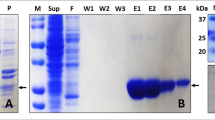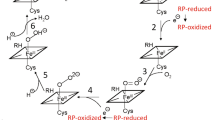Abstract
Protein disulfide bond formation is a rate limiting step in protein folding and is catalyzed by enzymes belonging to the protein disulfide oxidoreductase superfamily, including protein disulfide isomerase (PDI) in eucarya and DsbA in bacteria. The first high resolution X-ray crystal structure of a protein disulfide oxidoreductase from the hyperthermophilic archaeon Pyrococcus furiosus reveals structural details that suggest a relation to eukaryotic PDI. The protein consists of two homologous structural units with low sequence identity. Each unit contains a thioredoxin fold with a distinct CXXC active site motif. The accessibilities of both active sites are rather different as are, very likely, their redox properties. The protein shows the ability to catalyze the oxidation of dithiols as well as the reduction of disulfide bridges.
This is a preview of subscription content, access via your institution
Access options
Subscribe to this journal
Receive 12 print issues and online access
$189.00 per year
only $15.75 per issue
Buy this article
- Purchase on Springer Link
- Instant access to full article PDF
Prices may be subject to local taxes which are calculated during checkout






Similar content being viewed by others
Accession codes
References
Holmgren, A. Thioredoxin, Ann. Rev. Biochem. 54, 237–271 (1985).
Wells, W.W., Yang, Y. & Deits, T.L. Thioltransferases. Adv. Enzymol. 66, 149 –201 (1993).
Laurent, T.C., Moore, E.C. & Reichard, P. Enzymatic synthesis of deoxyribonucleotides IV. Isolation and characterization of thioredoxin, the hydrogen donor from Escherichia coli B. J. Biol. Chem. 239, 3436– 3444 (1964).
Holmgren, A. Hydrogen donor system for Escherichia coli ribonucleotide-diphosphate reductase dependent upon glutathione. Proc. Natl. Acad. Sci. USA 73, 2275 –2279 (1976).
Holmgren, A., Söderberg, B.O., Eklund, H. & Brändén, C.I. Three-dimensional structure of E. coli thioredoxin-S2 to 2.8 Å resolution. Proc. Natl. Acad. Sci. USA 72, 2305– 2309 (1975).
Söderberg, B.O., Sjöberg, B.M., Sonnerstam, U. & Brändén, C.I. Three-dimensional structure of thioredoxin induced by bacteriophage T4. Proc. Natl. Acad. Sci. USA 75, 5827– 5830 (1978).
Martin, J.L., Bardwell, J.C.A. & Kurigan, J. Crystal structure of the DsbA protein required for disulphide bond formation in vivo. Nature 365, 464 –468 (1993).
Martin, J.L. Thioredoxin—a fold for all reasons. Structure, 3, 245– 250 (1995).
Creighton, T.E. Disulfide formation in proteins. Meth. Enz. 107, 305 –329 (1984).
Bardwell, J.C.A., McGovern, K. & Beckwith, J. Identification of a protein required for disulfide bond formation in vivo. Cell 67, 581–589 (1991).
Zapun, A., Bardwell, J.C. & Creighton, T.E. The reactive and destablizing disulfide bond of DsbA, a protein required for protein disulfide bond formation in vivo. Biochemistry 32, 5083–5092 ( 1993).
Wunderlich, M., Jaenicke, R. & Glockshuber, R. The redox properties of protein disulfide isomerase (DsbA) of Escherichia coli result from a tense conformation of its oxidized form. J. Mol. Biol. 233, 559–566 ( 1993).
Zapun, A. & Creighton, T.E. Effects of DsbA on the disulfide folding of bovine pancreatic trypsin inhibitor and α-lactalbumin. Biochemistry 33, 5202–5211 (1994).
Goldberger, R.F., Epstein, C.J. & Anfinsen, C.B. Acceleration of reactivation of reduced bovine pancreatic ribonuclease by a microsomal system from rat liver. J. Biol. Chem. 238, 628–635 ( 1963).
Freedman, R.B., Hirst, T.R. & Tuite, M.F. Protein disulfide isomerase: building bridges in protein folding. Trends Biochem. Sci. 19, 331– 336 (1994).
Bardwell, J.C.A. & Beckwith, J. The bonds that tie: catalyzed disulfide bond formation. Cell 74, 769– 771 (1993).
Lambert, N. & Freedman, R.B. Structural properties of homogeneous protein disulphide-isomerase from bovine liver purified by a rapid high-yielding procedure. Biochem. J. 213, 225– 234 (1983).
Edman, J.C., Ellis, L., Blacher, R.W., Roth, R.A. & Rutter, W.J. Sequence of protein disulfide isomerase and implications of its relationship to thioredoxin. Nature 319, 267–270 (1985).
Kemmink, J., Darby, N.J., Dijkstra, K., Nilges, M. & Creighton, T.E. The folding catalyst protein disulfide isomerase is constructed of active and inactive thioredoxin modules. Curr. Biol. 7, 239–245 ( 1997).
McFarlan, S., Terrell, C.A. & Hogenkamp, H.P.C. The purification, characterization, and primary structure of a small redox protein from Methanobacterium thermoautotrophicum, an archaebacterium. J. Biol. Chem. 15, 10561– 10569 (1992).
Ren, B. et al. Crystallization and preliminary X-ray structure analysis of a hyperthermostable thioltransferase from the archaeon Pyrococcus furiosus. J. Struct. Biol, 119, 1–5 (1997).
Katti, S.K., LeMaster, D.M. & Eklund, H. Crystal structure of thioredoxin from Escherichia coli at 1.68 Å resolution. J. Mol. Biol. 212, 167– 184 (1990).
Eklund, H. et al. Structure of oxidized bacteriophage T4 glutaredoxin (thioredoxin): refinement of native and mutant proteins. J. Mol. Biol. 228, 596–618 (1992).
Kemmink, J., Darby, N.J., Dijkstra, K., Nilges, M. & Creighton, T.E. Structure determination of the N-terminal thioredoxin-like domain of protein disulfide isomerase using multidimensional heteronuclear 13C/15N NMR spectroscopy. Biochemistry 35, 7684–7691 (1996).
Guddat, L.W., Bardwell, J.C.A., Zander, T. & Martin, J. The uncharged surface features surrounding the active site of Escherichia coli DsbA are conserved and are implicated in peptide binding. Prot. Sci. 6 , 1148–1156 (1997).
Saarinen, M., Gleason, F.K. & Eklund, H. Crystal structure of thioredoxin-2 from Anabaena. Structure 3, 1097–1108 ( 1995).
Freedman, R.B. Folding helpers and unhelpful folders. Curr. Biol. 4, 933 –935 (1994).
Holmgren, A. Thioredoxin structure and mechanism: conformational changes on oxidation of the active-site sulfhydryls to a disulfide. Structure 3, 239–243 (1995).
Freedman, R.B. The formation of protein disulfide bonds. Curr. Opin. Struc. Biol. 5, 85–91 (1995).
Qin, J., Clore, G.M., Kennedy, W.P., Kuszewski, J. & Gronenborn, A.M. The solution structure of human thioredoxin complexed with its target from Ref-1 reveals peptide chain reversal. Structure 4, 613–620 ( 1996).
Fiala, G. & Stetter, K.O. Pyrococcus furiosus sp. nov. represents a novel genus of marine heterotrophic archaebacteria growing optimally at 100 °C. Arch. Microbiol. 145, 56–61 (1986).
Guagliardi, A. et al. The purification, cloning, and high level expression of a glutaredoxin-like protein from hyperthermophilic archaeon Pyrococcus furiosus. J. Biol. Chem. 270, 5748–5755 (1995).
Ruddock, L.W., Hirst, T.R. & Freedman, R.B. PH-dependence of the dithiol-oxidizing activity of DsbA (a periplasmic protein thiol:disulphide oxidoreductase) and protein disulphide-isomerase: studies with a novel simple peptide substrate. Biochem. J. 315, 1001–1005 (1996).
Darby, N.J., Kemmink, J. & Creighton, T.E. Identifying and characterizing a structural domain of protein disulfide isomerase. Biochemistry 35, 10517 –10528 (1996).
Noiva, R., Freedman, R.B. & Lennarz, W.J. Peptide binding to protein disulfide isomerase occurs at a site distinct from the active sites. J. Biol. Chem. 268, 10210–19217 (1993).
Bennett, C.F., Balcarek, J.M., Varrichio, A. & Crooke, S.T. Molecular cloning and complete amino-acid sequence of form-I phosphoinositide-specific phospholipase C. Nature 334, 268–270 (1988).
Van, P.N., Rupp, K., Lampen, A. & Söling, H.-D. CaBP2 is a rat homology of ERp72 with protein disulfide isomerase activity. Eur. J. Biochem. 213, 789–795 ( 1993).
Chaudhuri, M.M., Tonin, P.N., Lewis, W.H. & Srinivasan, P.R. The gene for a novel protein, a member of the protein disulfide isomerase/Form I phosphoinositide-specific phospholipase C family, is amplified in hydroxyurea-resistant cells. Biochem. J. 281, 645–650 (1992).
Hutchinson, E.G. & Thornton, J.M. PROMOTIF- A program to identify and analyze structural motifs in proteins. Prot. Sci. 5, 212–220 (1996).
Weiner, S.J. et al. A new force field for molecular mechanical simulation of nucleic acids and proteins. J. Am. Chem. Soc. 106, 765– 784 (1984).
Katz, B.A. & Kossiakoff, A. The crystallographically determined structures of atypical strained disulfides engineered into subtilisin. J. Biol. Chem. 261, 15480–15485 (1986).
Darby, N.T. & Creighton, T.E. Functional properties of the individual thioredoxin-like domains of protein disulfide isomerase. Biochemistry, 34, 11725–11735 (1995).
Vuori, K., Myllylä, R., Pihlajaniemi, T. & Kivirikko, K.I. Expression and site-directed mutagenesis of human protein disulfide isomerase in Escherichia coli. J. Biol. Chem. 267, 7211– 7214 (1992).
Chivers, P.T., Laboissière, M.C.A. & Raines, R.T. The CXXC motif: imperative for the formation of native disulfide bonds in the cell. EMBO J. 15, 2659–2667 (1996).
Hawkins, H.C., de Nardi, M. & Freedman, R.B. Redox properties and cross-linking of the dithiol/disulphide active sites of mammalian protein disulphide-isomerase. Biochem. J. 275, 341–348 ( 1991).
Christianson, D.W. Structural biology of zinc. Adv. Protein Chem., 42, 281–355 (1991).
Jones, S. & Thornton, J.M. Protein–protein interactions: a review of protein dimer structures. Prog. Biophys. Molec. Biol . 63, 31–65 ( 1995).
Yip, K.S.P. et al. The structure of Pyrococcus furiosus glutamate dehydrogenase reveals a key role for ion-pair networks in maintaining enzyme stability at extreme temperatures. Structure 2, 1147– 1158 (1995).
Kabsch, W. Evaluation of single crystal x-ray diffraction data from a position sensitive detector. J. Appl. Crystallogr. 21, 916–924 (1988).
Otwinowski, Z. & Minor, W. Processing of X-ray diffraction data collected in oscillation mode. Meth. Enz. 276, 307–326 (1997).
Otwinowski, Z. Maximum likelihood refinement of heavy atom parameters. In Isomorphous Replacement and Anomalous Scattering. (eds Wolf, W., Evans, P. R. & Leslie, A. G. W.) 80–86 (Daresbury Laboratory, Daresbury, UK; 1991).
Cowtan, K. An automated procedure for phase improvement by density modification. Joint CCP4 and ESF-EACBM Newsletter on Protein Crystallography 31, 34– 38 (1994).
Jones, T.A., Zou, J.Y., Cowan, S.W. & Kjeldgaard, M. Improved methods for building protein models in electron density maps and the location of errors in the model. Acta Crystallogr. A 47, 110 –119 (1991).
Brünger, A.T. XPLOR, version 3.1. A System for X-ray Crystallography and NMR. (Yale University Press, New Haven, Connecticut; 1992).
Brünger, A.T. The free R value: a novel statistical quantity for assessing the accuracy of crystal structures. Nature 355, 472– 474 (1992).
Acknowledgements
This work was supported by the European Commission project: Extremophiles as Cell Factories.
Author information
Authors and Affiliations
Corresponding author
Rights and permissions
About this article
Cite this article
Ren, B., Tibbelin, G., de Pascale, D. et al. A protein disulfide oxidoreductase from the archaeon Pyrococcus furiosus contains two thioredoxin fold units. Nat Struct Mol Biol 5, 602–611 (1998). https://doi.org/10.1038/862
Received:
Accepted:
Issue Date:
DOI: https://doi.org/10.1038/862
This article is cited by
-
Disulfide bond formation in prokaryotes
Nature Microbiology (2018)
-
Sulfur–Sulfur Bond Construction
Topics in Current Chemistry (2018)
-
Redox regulation of SurR by protein disulfide oxidoreductase in Thermococcus onnurineus NA1
Extremophiles (2017)
-
Sulfolobus solfataricus thiol redox puzzle: characterization of an atypical protein disulfide oxidoreductase
Extremophiles (2014)
-
Multiple catalytically active thioredoxin folds: a winning strategy for many functions
Cellular and Molecular Life Sciences (2010)



